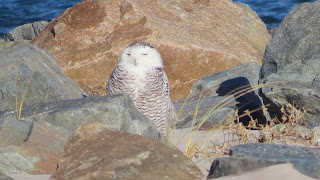Yesterday, Friday December 27, I met Eileen Schwinn and Mike Higgiston (the East Quogue birding contingent) at Cupsogue to participate in the annual Central Suffolk Christmas Bird Count. We covered Cupsogue west from the parking lot to the Moriches Inlet and then Dune Road east all the way to Shinnecock Inlet. Only the part west of the western Westhampton Bridge was actually officially part of the count (got that?) but the birds ignored that fact and so will I!
The big find of the day was actually not a bird but a haulout of almost 100 seals on one of the sand island in Moriches Bay -- most of them presumably Harbor Seals. Not far behind were the Snowy Owls -- three of them between the two inlets and a fourth on the far side of Shinnecock Inlet. This has been an extraordinary year for the Snowies (a.k.a. the Harry Potter Owl). There were no less than 15 of them on the Brooklyn Christmas Count a couple of weeks ago and JFK was so inundated that the airport authorities were shooting them before protest erupted and forced them to change policy and relocate them instead. Who knows how many more there were on the LI shore between NYC and ELI? This was a bonanza for birders and nature lovers but perhaps not for the owls. The most likely explanation for the periodic invasion of these tundra denizens is a high population of young birds of the year and a decline in the populations of lemmings and other prey up north. When these dramatic owls arrive, they almost always hang out on the shore, generally in the dunes which are the closest local environment to match their home habitat. They are mostly young birds and they are active in the daylight; let's hope they find nourishment here before they have to return back north. See Eileen's photographs attached herein.
The small birds in Eileen's photos are another visitor from the far north with a similar name. The Snow Bunting gets the epithet 'snow' because, like the owl (and like the smaller of our egrets) it carries a lot of white in its plumage. Also a tundra dweller and a winter visitor in these parts, this bird appears in twittery flocks in the dunes and it comes almost every year.
Other birds of interest were Northern Harriers (at least four seen over the dunes and marshes); Horned Grebes at Moriches Inlet; Common and Red-throated Loons in inlet, bay and ocean; at least one Northern Gannet (way out on the ocean); and various winter waterfowl including small numbers of Brant, a flock of Common Eiders in and around Shinnecock Inlet, scoters in large numbers moving off-shore (and unidentifiable as to species), Long-tailed Ducks in their winter plumages (at both inlets), Red-breasted Mergansers all around, a small flock of Common Goldeneye at Pike's Beach, and many hundreds of Black Duck everywhere. The only shorebirds that could be identified were Sanderlings and a few Dunlin. Two Glaucous Gulls -- a big all-white sometime winter visitor -- were reported from Shinnecock but we couldn't find them. Even more strikingly missing were the 'bluebills' -- Greater Scaup which which have traditionally wintered on the south shore bays in large numbers. Duck hunting season was still in progress (we could hear the occasional pop of guns) which may have accounted for the scarcity (and the flightiness) of many of the waterfowl.
Eric Salzman
Saturday, December 28, 2013
Subscribe to:
Posts (Atom)





